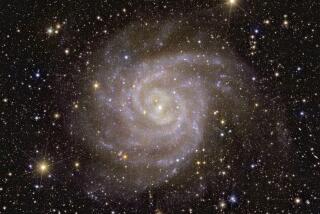First Snapshot a Work of Art to Hubble Staff
GREENBELT, Md. — The Hubble Space Telescope on Sunday transmitted its first image back to Earth, where National Aeronautics and Space Administration astronomers greeted with exuberance the historic snapshot’s surprising clarity.
“It’s quite an image--fantastic,” said James Westphal, the principal scientist for the camera used in the first photo exercise. At the Goddard Space Flight Center here, the finished photo was displayed on a television monitor, revealing dozens of individual suns within a Southern Hemisphere star cluster.
“We are just as pleased as punch at this point,” Westphal said. “Our image is significantly better than we (thought) it might be.”
Indeed, the $1.5-billion Hubble scope survived a trouble-plagued launch from the shuttle Discovery on April 25 and at times it seemed doubtful that the powerful astronomical observatory would soon be transmitting images.
NASA engineers had hoped to take the first picture about a week after the telescope was deployed but instead had to struggle to align and focus the instruments, as well as correct computer problems, a fouled antenna and a programming error that resulted from a simple math miscalculation.
However, Sunday morning that snafu-riddled history seemed light-years away as the telescope successfully collected information about Theta Carina, a Milky Way star cluster that is located about 1,260 light-years--or about 7,408,000,000,000,000 miles--from Earth.
As the 12-ton observatory orbited 381 miles above Jayapura, New Guinea, the shutter of its wide-field planetary camera opened for one second to take the first black-and-white picture. That photo and a second exposure lasting 30 seconds were stored on magnetic tape and relayed to the ground.
Engineers took more than an hour to change the raw electronic data from Hubble into a properly contrasting picture on a TV screen, manipulating separate sets of the image as spectators watched.
The picture from the 30-second exposure revealed dozens of stars in the star cluster. It made a “pretty good target” for the test photo, said NASA spokesman Randee Exler, because of its relative brightness and size. The cluster is so large that, to the naked eye from Earth, it appears twice as wide as the moon, Exler said.
Comparing the Hubble image with a ground-based photo of the same stars, NASA scientists showed that the space telescope was on target and in better focus than anticipated.
Of particular note, what had been believed to be one star clearly showed up as two separate stars, thanks to the Hubble telescope’s state-of-the-art optical system.
While the finished photo did not provoke “oohs” and “aahs” from the spectators, it did prove a vindication for those working most closely to the project, 15 years in the making.
“I don’t get excited easily, but I’m ecstatic,” project scientist Albert Boggess said. “We had been anticipating images that were larger and perhaps a little fuzzier than these look.”
Once the telescope completes eight months of testing, the observatory is expected to yield images 10 times clearer than those possible with ground-based instruments--and at least seven times sharper than the one released Sunday.
With its 94.5-inch-diameter mirror and powerful light-amplifying and focusing equipment, the orbiting telescope is expected to take photos of stars that are 25 times fainter than the dimmest object visible from Earth.
To accomplish this, the telescope is designed to hold so steady that its movement would be less than the thickness of a sheet of paper. Its pointing system is described as so accurate that if it were mounted atop the Washington Monument with a laser gun it could hold a steady light beam on a dime atop the Empire State Building in New York City.
More to Read
Sign up for Essential California
The most important California stories and recommendations in your inbox every morning.
You may occasionally receive promotional content from the Los Angeles Times.










